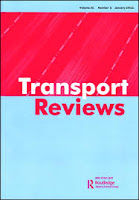Jacqueline Klopp (Twitter) and Clemence Cavoli (Twitter) have a new paper reviewing some trends in transportation planning in African cities with a focus on paratransit. The paper also discusses why official transportation planning should engage with paratransit services and how this task can be supported through collaborative mapping projects that open new avenues for data accountability.
The paper is open access (see link below) and it draws attention to DigitalTransport4Africa.org, an initiative working "to scale up these mapping efforts and promote open data and sharing, open source tools and exchange and learning between African cities to build local data infrastructure, eco-systems and local capacities". Thanks to this initiative, one can easily find for example the GTFS data of cities such as Nairobi, Maputo, Accra and Cairo and others. Jackie and others are working to build a similar initiative in Latin America and I hope I will soon bring more info about this. Stay tuned.
Abstract:
Often called paratransit because of their flexible stops, schedules and routes, minibuses make up the bulk of public transport in African cities. Despite their ubiquity and importance, these systems are poorly understood by transportation planners who tend to focus on large-scale urban infrastructure projects such as highways, commuter rail or bus rapid transit systems. The assumption within much of this planning is that these minibus systems are barriers to change and will become at most secondary “feeder” buses within large-scale projects, but structured plans detailing this vision are lacking. This paper argues that frequent failure to collect data and value important paratransit systems as a critical part of transportation in their own right is deeply problematic from the point of view of equity, access and inclusive and effective planning. We ask whether the growing number of bottom up mapping projects of minibus systems can disrupt this status quo. By comparing two mapping projects, Digital Matatus in Nairobi and the Mapa Dos Chapas in Maputo, we find that inclusive, collaborative mapping can help render these minibuses more visible in planning and provoke more grounded and inclusive “planning conversations” on multi-modal integration, passenger information and minibus upgrading, all key but relatively marginalised aspects of creating accessible, low emission, high quality and safe public transport in African cities.
